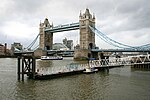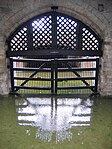Hawker Hunter Tower Bridge incident
1960s crimes in London1968 in London1968 in aviation1968 in military history20th-century history of the Royal Air Force ... and 7 more
Accidents and incidents involving Royal Air Force aircraftApril 1968 events in the United KingdomAviation accidents and incidents in 1968Aviation accidents and incidents in LondonHistory of the River ThamesHistory of the Royal Air ForceUse British English from May 2011

The Hawker Hunter Tower Bridge incident occurred on 5 April 1968, when Royal Air Force (RAF) Hawker Hunter pilot Alan Pollock performed unauthorised low flying over several London landmarks and then flew through the span of Tower Bridge on the River Thames. His actions were to mark the 50th anniversary of the founding of the RAF and as a demonstration against the Ministry of Defence for not recognising it.Upon landing Pollock was arrested and later invalided out of the RAF on medical grounds, which avoided a court martial.
Excerpt from the Wikipedia article Hawker Hunter Tower Bridge incident (License: CC BY-SA 3.0, Authors, Images).Hawker Hunter Tower Bridge incident
Tower Bridge, London Bermondsey (London Borough of Southwark)
Geographical coordinates (GPS) Address Nearby Places Show on map
Geographical coordinates (GPS)
| Latitude | Longitude |
|---|---|
| N 51.505555555556 ° | E -0.075555555555556 ° |
Address
Tower Bridge
Tower Bridge
SE1 2UP London, Bermondsey (London Borough of Southwark)
England, United Kingdom
Open on Google Maps










